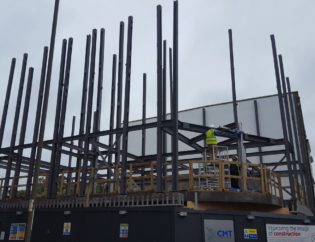
The Steel Industry in Transition
As we step further into 2025, the steel fabrication industry stands at a significant turning point. What was once a sector driven primarily by brute strength and volume has evolved into a high-tech, innovation-led ecosystem. The forces reshaping this field go beyond simple supply-and-demand cycles. Climate goals, digitalization, labor shortages, global construction demands, and architectural experimentation are all converging to redefine what steel fabrication means.
For companies like Has Metal Work, which specialize in precision steel structures for industrial, commercial, and architectural applications, keeping pace with these changes is not optional—it is essential for survival and growth. Steel is no longer just a material. It is now a platform for innovation, a medium for design freedom, and a driver of environmental progress.

Sustainability is No Longer a Niche Concern
Green Steel and the Push for Decarbonization
Perhaps the most influential trend driving the future of steel fabrication is the global shift toward sustainability. With climate change no longer a future threat but a present reality, stakeholders in construction, infrastructure, and manufacturing are under intense pressure to reduce their carbon footprints. This means that the steel industry—one of the world’s largest industrial CO₂ emitters—is being forced to transform.
The rise of “green steel” is one of the most important developments of this transformation. Produced using hydrogen instead of coal in the reduction process, green steel offers a path to dramatically lowering emissions without compromising material strength. In Europe especially, legislation and public-private initiatives are accelerating its adoption.
At Has Metal Work, we are monitoring these developments closely, and wherever possible, we collaborate with suppliers who follow cleaner production practices. As demand for green-certified buildings and sustainable materials increases, steel fabricators who can provide documentation and traceability for low-emission products will be at a competitive advantage.

Automation and Digital Fabrication
AI, Robotics, and Industry 4.0 in Steel Manufacturing
Digitalization is revolutionizing every corner of the construction supply chain, and steel fabrication is no exception. From robotic welding arms to AI-driven quality control systems, fabrication workshops are quickly evolving into smart factories. These systems don’t just improve speed—they dramatically reduce the margin of error, improve repeatability, and enhance worker safety.
Advanced CAD-to-machine interfaces now allow digital blueprints to be fed directly into cutting and forming machines, bypassing traditional human interpretation. This reduces costly miscommunication between design and production teams. Additionally, Building Information Modeling (BIM) is becoming the new standard in project integration, enabling real-time collaboration between architects, structural engineers, and fabricators.
Has Metal Work is embracing this digital shift by investing in intelligent workshop tools, data-driven production management, and technical training. We believe that technology should not replace human experience—but rather empower it. In our operations, seasoned engineers and skilled tradespeople work hand in hand with digital systems to create steel components that are both smart and strong.
Customization and Design Freedom
Beyond Standard Profiles: Meeting Complex Project Needs
One of the major evolutions in steel fabrication is the shift from mass-produced standard profiles to highly customized, project-specific components. Today’s architects and builders no longer want off-the-shelf materials. Instead, they expect their structural elements to conform exactly to their project’s dimensions, performance requirements, and aesthetic ambitions.
This trend is being driven by the increasing complexity of architectural forms, especially in urban construction. Curved facades, multi-angle load paths, and hybrid structures require steel components that are geometrically unique yet structurally flawless. At Has Metal Work, we specialize in translating complex concepts into manufacturable realities. Our workshop capabilities allow for flexible production, quick prototyping, and just-in-time delivery of custom elements tailored to each project’s needs.
Advanced Alloys and Smart Materials
Innovation in Metallurgy and Structural Intelligence
Alongside the push for greener and more versatile materials, the field of metallurgy is undergoing rapid innovation. New alloy compositions are emerging that enhance strength while reducing weight, corrosion resistance, and cost. At the same time, “smart materials”—metals embedded with sensors or shape-memory properties—are slowly making their way into mainstream structural applications.
While these materials are still in their early adoption phase, they promise exciting future possibilities: bridges that self-report structural fatigue, load-bearing beams that react to temperature, and modular frames that adapt to new architectural demands. For fabricators, this trend signals the need to rethink traditional methods of connection, welding, and handling.
Has Metal Work is actively exploring how these emerging materials can be incorporated into our workflow, especially for sectors where lifecycle performance and data integration are mission-critical.

Globalization and Supply Chain Resilience
Local Fabrication, Global Coordination
The COVID-19 pandemic and recent geopolitical tensions have exposed the vulnerabilities of global supply chains, especially in heavy industries. As a result, many developers and contractors are now seeking local fabrication partners who can offer greater reliability, faster turnaround, and direct communication.
At the same time, major infrastructure and industrial projects are increasingly international in scope, requiring coordination across multiple geographies. This has led to the rise of hybrid fabrication strategies, where design may happen in one country, steel sourced from another, and assembly coordinated elsewhere.
Has Metal Work has adapted to this model by establishing strong communication protocols, multilingual project documentation, and flexible logistics. Our experience on cross-border projects—especially in Germany and the UK—gives us the agility needed to thrive in this globally distributed industry.
Workforce Evolution and Training
Bridging the Skills Gap in the Steel Sector
As the tools and technologies of steel fabrication change, so too must the workforce. There is an urgent need for professionals who can bridge the gap between hands-on manufacturing and digital project execution. Unfortunately, many fabrication companies are struggling with aging workforces and a shortage of qualified welders, CNC operators, and fabrication engineers.
To address this, Has Metal Work places a high priority on in-house training and mentoring programs. By pairing experienced craftsmen with younger technicians, we create a knowledge pipeline that combines traditional skill with modern precision. In doing so, we prepare our workforce not just for today’s challenges, but for the complexities of tomorrow’s projects.
The Future Is Being Built Today
The future of steel fabrication is already unfolding—one innovation, one project, one breakthrough at a time. From green steel to AI-powered workshops, from custom-designed components to global coordination, the industry is undergoing profound transformation. At the heart of this evolution is a simple truth: the demand for stronger, smarter, and more sustainable structures is only going to grow.
At Has Metal Work, we stand ready to meet that demand. With a foundation rooted in engineering excellence and an eye on the technologies of tomorrow, we don’t just follow the trends—we shape them.





You must be logged in to post a comment.